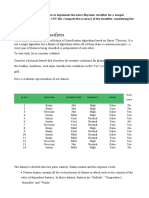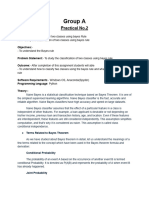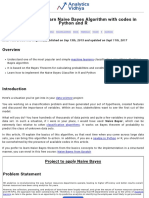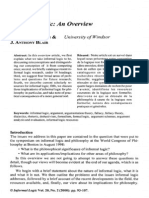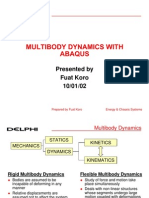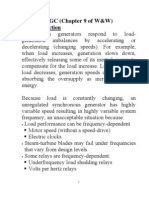Assignment No 2
Uploaded by
ADITYA PATILAssignment No 2
Uploaded by
ADITYA PATILAssignment No.
- 2
TITLE: NAÏVE BAYES IMPLEMENTATION FOR CLASSIFYING DIABETES USING
PIMA INDIANS DATASET
Aim :
Implement a classification algorithm that is Naïve Bayes. Implement the following
operations:
1. Split the dataset into Training and Test dataset.
2. Calculate conditional probability of each feature in training dataset.
3. Classify sample from a test dataset.
4. Display confusion matrix with predicted and actual values.
Pre-Requisite:
Fundamentals of R -Programming Languages
Naïve Bayes classification algorithm
Naive Bayes Classifiers
This article discusses the theory behind the Naive Bayes classifiers and their implementation.
Naive Bayes classifiers are a collection of classification algorithms based on Bayes’ Theorem. It
is not a single algorithm but a family of algorithms where all of them share a common principle,
i.e. every pair of features being classified is independent of each other.
To start with, let us consider a dataset.
Consider a fictional dataset that describes the weather conditions for playing a game of golf. Given
the weather conditions, each tuple classifies the conditions as fit(“Yes”) or unfit(“No”) for plaing
golf.
MITCOE,Dept. of Computer Engg. Laboratory Practice -I
Dataset:
Assumption:
The fundamental Naive Bayes assumption is that each feature makes an:
Independent
Equal
contribution to the outcome.
With relation to our dataset, this concept can be understood as:
We assume that no pair of features are dependent. For example, ‘Rainy’ has no effect on
the winds. Hence, the features are assumed to be independent.
Secondly, each feature is given the same weight(or importance). For example, knowing
only temperature and humidity alone can’t predict the outcome accurately. None of the
attributes is irrelevant and assumed to be contributing equally to the outcome.
MITCOE,Dept. of Computer Engg. Laboratory Practice -I
Bayes’ Theorem
Bayes’ Theorem finds the probability of an event occurring given the probability of another event
that has already occurred. Bayes’ theorem is stated mathematically as the following equation:
where A and B are events and P(B) > 0.
Basically, we are trying to find probability of event A, given the event B is true. Event B
is also termed as evidence.
P(A) is the priori of A (the prior probability, i.e. Probability of event before evidence is
seen). The evidence is an attribute value of an unknown instance(here, it is event B).
P(A|B) is a posteriori probability of B, i.e. probability of event after evidence is seen.
Now, with regards to our dataset, we can apply Bayes’ theorem in following way:
where, y is class variable and X is a dependent feature vector (of size n) where:
Naive assumption
Now, its time to put a naive assumption to the Bayes’ theorem, which is, independence among
the features. So now, we split evidence into the independent parts.
Now, if any two events A and B are independent, then,
which can be expressed as:
Now, as the denominator remains constant for a given input, we can remove that term:
Let us test it on a new set of features (let us call it today):
today = (Sunny, Hot, Normal, False)
MITCOE,Dept. of Computer Engg. Laboratory Practice -I
So, probability of playing golf is given by:
and probability to not play golf is given by:
Since, P(today) is common in both probabilities, we can ignore P(today) and find proportional
probabilities as:
and
and
and
These numbers can be converted into a probability by making the sum equal to 1 (normalization):
and
and
So, prediction that golf would be played is ‘Yes’.
The method that we discussed above is applicable for discrete data. In case of continuous data, we need to
make some assumptions regarding the distribution of values of each feature
Applications:
Real time Prediction: Naive Bayes is an eager learning classifier and it is sure fast. Thus,
it could be used for making predictions in real time.
Multi class Prediction: This algorithm is also well known for multi class prediction
feature. Here we can predict the probability of multiple classes of target variable.
Text classification/ Spam Filtering/ Sentiment Analysis: Naive Bayes classifiers mostly
used in text classification (due to better result in multi class problems and independence
rule) have higher success rate as compared to other algorithms. As a result, it is widely
MITCOE,Dept. of Computer Engg. Laboratory Practice -I
used in Spam filtering (identify spam e-mail) and Sentiment Analysis (in social media
analysis, to identify positive and negative customer sentiments)
Recommendation System: Naive Bayes Classifier and Collaborative Filtering together
builds a Recommendation System that uses machine learning and data mining techniques
to filter unseen information and predict whether a user would like a given resource or not
Input:
Structured Dataset : PimaIndiansDiabetes Dataset
File: PimaIndiansDiabetes.csv
Output:
1. Splitted dataset according to Split ratio.
2. Conditional probability of each feature.
3. Visualization of the performance of an algorithm with confusion matrix
Conclusion:
Hence, using naïve bayes classification algorithm, the classification on Pima Indians
Dataset is performed using Python program
MITCOE,Dept. of Computer Engg. Laboratory Practice -I
You might also like
- Naive Bayes Classifier in Machine Learning - JavatpointNo ratings yetNaive Bayes Classifier in Machine Learning - Javatpoint19 pages
- Unit-4 Naïve Bayes & Support Vector MachineNo ratings yetUnit-4 Naïve Bayes & Support Vector Machine79 pages
- Naive Bayes Classifier in Machine LearningNo ratings yetNaive Bayes Classifier in Machine Learning16 pages
- Notes On Module 3 - Pattern RecognitionNo ratings yetNotes On Module 3 - Pattern Recognition17 pages
- Lecture Slide 03 - Bayesian Classifier - Summer 2023No ratings yetLecture Slide 03 - Bayesian Classifier - Summer 202323 pages
- 6 Easy Steps To Learn Naive Bayes Algorithm With Codes in Python and RNo ratings yet6 Easy Steps To Learn Naive Bayes Algorithm With Codes in Python and R6 pages
- 6 Easy Steps To Learn Naive Bayes Algorithm (With Code in Python)No ratings yet6 Easy Steps To Learn Naive Bayes Algorithm (With Code in Python)3 pages
- ML Unit No.4 Naïve Bayes Classifiers PPT NotesNo ratings yetML Unit No.4 Naïve Bayes Classifiers PPT Notes47 pages
- 20210913115710D3708 - Session 09-12 Bayes ClassifierNo ratings yet20210913115710D3708 - Session 09-12 Bayes Classifier30 pages
- Lecture-7 Classification Using Naive BaysNo ratings yetLecture-7 Classification Using Naive Bays19 pages
- Bayesian Classification: Cse 634 Data Mining - Prof. Anita WasilewskaNo ratings yetBayesian Classification: Cse 634 Data Mining - Prof. Anita Wasilewska66 pages
- Johnson and Blair - Informal Logic - An OverviewNo ratings yetJohnson and Blair - Informal Logic - An Overview15 pages
- Maths Class Xii Chapter 01 Relations and Functions Practice Paper 01 2024 AnswersNo ratings yetMaths Class Xii Chapter 01 Relations and Functions Practice Paper 01 2024 Answers7 pages
- MG 412 Advanced Hyrdometallugy Test 1 2017 Eng. T R Sithole: InstructionNo ratings yetMG 412 Advanced Hyrdometallugy Test 1 2017 Eng. T R Sithole: Instruction2 pages
- PDE and Hypersurfaces With Prescribed Mean Curvature: Yunelsy N. AlvarezNo ratings yetPDE and Hypersurfaces With Prescribed Mean Curvature: Yunelsy N. Alvarez78 pages
- Traffic Impact Assesment Practice in IndonesiaNo ratings yetTraffic Impact Assesment Practice in Indonesia6 pages
- Thiagarajar College of Engineering, Madurai - 625 105 Department of Mechanical EngineeringNo ratings yetThiagarajar College of Engineering, Madurai - 625 105 Department of Mechanical Engineering2 pages
- (Projects) en Developing Pupil Competences Through ETwinningNo ratings yet(Projects) en Developing Pupil Competences Through ETwinning60 pages
- First Part of This Tutorial On The Java 8 Stream Api: Map Maptoint Maptolong MaptodoubleNo ratings yetFirst Part of This Tutorial On The Java 8 Stream Api: Map Maptoint Maptolong Maptodouble21 pages
- Review of Signals and Systems: Gaurav S. Kasbekar Dept. of Electrical Engineering IIT BombayNo ratings yetReview of Signals and Systems: Gaurav S. Kasbekar Dept. of Electrical Engineering IIT Bombay32 pages
- Cambridge O Level: Mathematics (Syllabus D) 4024/21No ratings yetCambridge O Level: Mathematics (Syllabus D) 4024/2120 pages
- Naive Bayes Classifier in Machine Learning - JavatpointNaive Bayes Classifier in Machine Learning - Javatpoint
- Lecture Slide 03 - Bayesian Classifier - Summer 2023Lecture Slide 03 - Bayesian Classifier - Summer 2023
- 6 Easy Steps To Learn Naive Bayes Algorithm With Codes in Python and R6 Easy Steps To Learn Naive Bayes Algorithm With Codes in Python and R
- 6 Easy Steps To Learn Naive Bayes Algorithm (With Code in Python)6 Easy Steps To Learn Naive Bayes Algorithm (With Code in Python)
- 20210913115710D3708 - Session 09-12 Bayes Classifier20210913115710D3708 - Session 09-12 Bayes Classifier
- Bayesian Classification: Cse 634 Data Mining - Prof. Anita WasilewskaBayesian Classification: Cse 634 Data Mining - Prof. Anita Wasilewska
- Bayesian Inference: Fundamentals and ApplicationsFrom EverandBayesian Inference: Fundamentals and Applications
- Naive Bayes Classifier: Fundamentals and ApplicationsFrom EverandNaive Bayes Classifier: Fundamentals and Applications
- Bayesian Methodology: an Overview With The Help Of R SoftwareFrom EverandBayesian Methodology: an Overview With The Help Of R Software
- Maths Class Xii Chapter 01 Relations and Functions Practice Paper 01 2024 AnswersMaths Class Xii Chapter 01 Relations and Functions Practice Paper 01 2024 Answers
- MG 412 Advanced Hyrdometallugy Test 1 2017 Eng. T R Sithole: InstructionMG 412 Advanced Hyrdometallugy Test 1 2017 Eng. T R Sithole: Instruction
- PDE and Hypersurfaces With Prescribed Mean Curvature: Yunelsy N. AlvarezPDE and Hypersurfaces With Prescribed Mean Curvature: Yunelsy N. Alvarez
- Thiagarajar College of Engineering, Madurai - 625 105 Department of Mechanical EngineeringThiagarajar College of Engineering, Madurai - 625 105 Department of Mechanical Engineering
- (Projects) en Developing Pupil Competences Through ETwinning(Projects) en Developing Pupil Competences Through ETwinning
- First Part of This Tutorial On The Java 8 Stream Api: Map Maptoint Maptolong MaptodoubleFirst Part of This Tutorial On The Java 8 Stream Api: Map Maptoint Maptolong Maptodouble
- Review of Signals and Systems: Gaurav S. Kasbekar Dept. of Electrical Engineering IIT BombayReview of Signals and Systems: Gaurav S. Kasbekar Dept. of Electrical Engineering IIT Bombay
- Cambridge O Level: Mathematics (Syllabus D) 4024/21Cambridge O Level: Mathematics (Syllabus D) 4024/21

